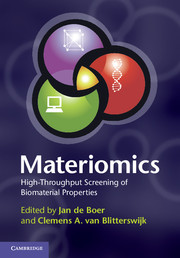Book contents
- Frontmatter
- Contents
- List of contributors
- Preface
- Chapter 1 Introducing materiomics
- Chapter 2 Physico-chemical material properties and analysis techniques relevant in high-throughput biomaterials research
- Chapter 3 Materiomics using synthetic materials: metals, cements, covalent polymers and supramolecular systems
- Chapter 4 Microfabrication techniques in materiomics
- Chapter 5 Bioassay development
- Chapter 6 High-content imaging
- Chapter 7 Computational analysis of high-throughput material screens
- Chapter 8 Upscaling of high-throughput material platforms in two and three dimensions
- Chapter 9 Development of materials for regenerative medicine: from clinical need to clinical application
- Chapter 10 Non-biomedical applications of materiomics
- Chapter 11 Beyond bed and bench
- Index
- References
Chapter 2 - Physico-chemical material properties and analysis techniques relevant in high-throughput biomaterials research
Published online by Cambridge University Press: 05 April 2013
- Frontmatter
- Contents
- List of contributors
- Preface
- Chapter 1 Introducing materiomics
- Chapter 2 Physico-chemical material properties and analysis techniques relevant in high-throughput biomaterials research
- Chapter 3 Materiomics using synthetic materials: metals, cements, covalent polymers and supramolecular systems
- Chapter 4 Microfabrication techniques in materiomics
- Chapter 5 Bioassay development
- Chapter 6 High-content imaging
- Chapter 7 Computational analysis of high-throughput material screens
- Chapter 8 Upscaling of high-throughput material platforms in two and three dimensions
- Chapter 9 Development of materials for regenerative medicine: from clinical need to clinical application
- Chapter 10 Non-biomedical applications of materiomics
- Chapter 11 Beyond bed and bench
- Index
- References
Summary
Scope
High-throughput and combinatorial research on biomaterials aims at the rapid development of new materials and the establishment of structure–function relationships. Therefore, knowledge of the chemistry of each material and its impact on physical properties is essential to understand the effect on its function as a biomaterial. A tutorial on basic physical and chemical properties of (polymeric) materials highlights these features and can be found in the first part of this chapter. The second part gives an overview of relevant techniques that can be used to screen these material properties in high throughput. In addition, several examples are described in which these methods are used to develop structure–function relationships between material properties and biological performance.
Basic principles: physical and chemical properties of polymeric biomaterials
Chemistry is a constant factor from which the performance of most (polymeric) biomaterials can be predicted, but this extrapolation becomes less obvious when numerous materials are mixed in huge combinatorial libraries. Therefore, researchers are becoming increasingly involved in high-throughput material research when successful correlations between biological performance and physico-chemical material properties are to be made. This accelerating trend can be extracted from many studies where high-throughput technologies are successfully applied to measure physical properties and biological performance of many different polymeric biomaterials. Physical properties such as hardness, topography and hydrophilicity are known to be important parameters in the biological evaluation of materials, because they allow or block the adhesion of biological compounds which is required to allow cell-spreading, migration, proliferation and differentiation. These properties are naturally different for every material or combination of materials, and relate primarily to the variable properties on the chemical level (molecular structure, functional groups and degradation). Therefore, the chemistry of a biomaterial directly contributes to its interaction with biological environments.
- Type
- Chapter
- Information
- MateriomicsHigh-Throughput Screening of Biomaterial Properties, pp. 13 - 30Publisher: Cambridge University PressPrint publication year: 2013



